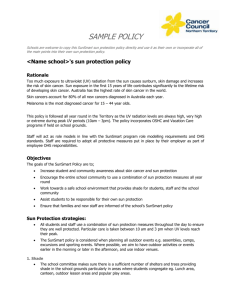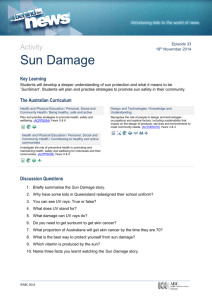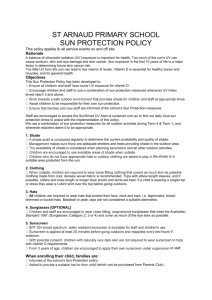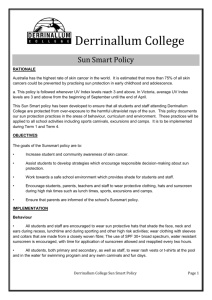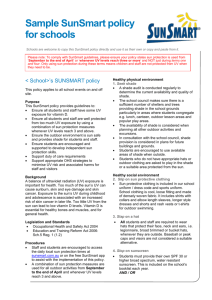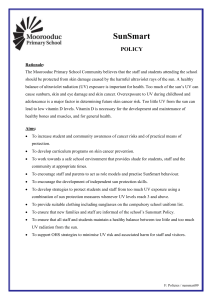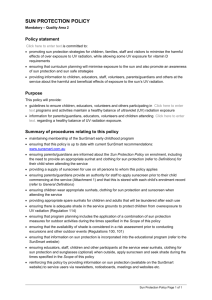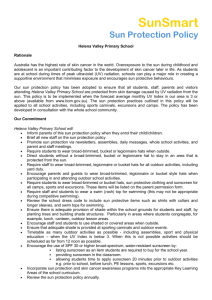Early childhood and care sample SunSmart policy
advertisement
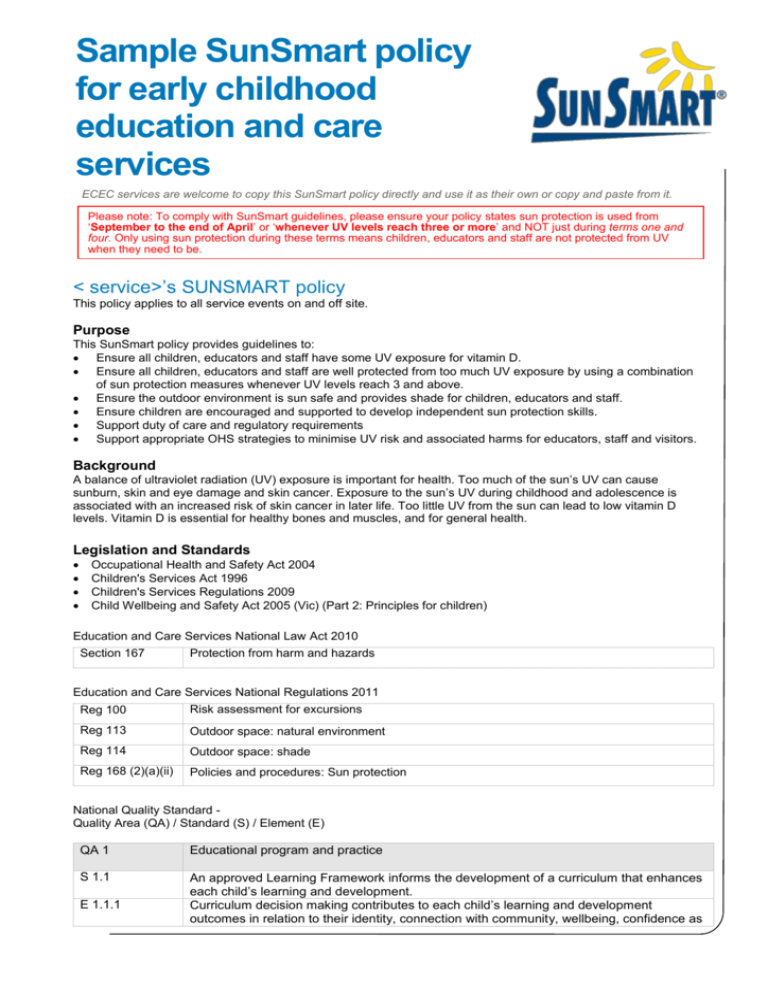
Sample SunSmart policy for early childhood education and care services ECEC services are welcome to copy this SunSmart policy directly and use it as their own or copy and paste from it. Please note: To comply with SunSmart guidelines, please ensure your policy states sun protection is used from ‘September to the end of April’ or ‘whenever UV levels reach three or more’ and NOT just during terms one and four. Only using sun protection during these terms means children, educators and staff are not protected from UV when they need to be. < service>’s SUNSMART policy This policy applies to all service events on and off site. Purpose This SunSmart policy provides guidelines to: Ensure all children, educators and staff have some UV exposure for vitamin D. Ensure all children, educators and staff are well protected from too much UV exposure by using a combination of sun protection measures whenever UV levels reach 3 and above. Ensure the outdoor environment is sun safe and provides shade for children, educators and staff. Ensure children are encouraged and supported to develop independent sun protection skills. Support duty of care and regulatory requirements Support appropriate OHS strategies to minimise UV risk and associated harms for educators, staff and visitors. Background A balance of ultraviolet radiation (UV) exposure is important for health. Too much of the sun’s UV can cause sunburn, skin and eye damage and skin cancer. Exposure to the sun’s UV during childhood and adolescence is associated with an increased risk of skin cancer in later life. Too little UV from the sun can lead to low vitamin D levels. Vitamin D is essential for healthy bones and muscles, and for general health. Legislation and Standards Occupational Health and Safety Act 2004 Children's Services Act 1996 Children's Services Regulations 2009 Child Wellbeing and Safety Act 2005 (Vic) (Part 2: Principles for children) Education and Care Services National Law Act 2010 Section 167 Protection from harm and hazards Education and Care Services National Regulations 2011 Reg 100 Risk assessment for excursions Reg 113 Outdoor space: natural environment Reg 114 Outdoor space: shade Reg 168 (2)(a)(ii) Policies and procedures: Sun protection National Quality Standard Quality Area (QA) / Standard (S) / Element (E) QA 1 Educational program and practice S 1.1 An approved Learning Framework informs the development of a curriculum that enhances each child’s learning and development. Curriculum decision making contributes to each child’s learning and development outcomes in relation to their identity, connection with community, wellbeing, confidence as E 1.1.1 Sample SunSmart policy for early childhood education and care services E 1.1.2 E 1.1.3 E 1.1.5 learners and effectiveness as communicators. Each child’s current knowledge, ideas, culture, abilities and interests are the foundation of the program. The program, including routines, is organised in ways that maximise opportunities for each child’s learning. Every child is supported to participate in the program. QA 2 Each child’s agency is promoted, enabling them to make choices and decisions and to influence events and their world. Educators and co-ordinators are focused, active and reflective in designing and delivering the program for each child. Educators respond to children's ideas and play and use intentional teaching to scaffold and extend each child's learning. Children’s health and safety S 2.1 Each child’s health is promoted. E 2.1.1 Each child’s health needs are supported. S 2.3 Each child is protected. E 2.3.2 QA 3 Every reasonable precaution is taken to protect children from harm and any hazard likely to cause injury. Physical environment S 3.1 The design and location of the premises is appropriate for the operation of a service. E 3.1.1 Outdoor and indoor spaces, buildings, furniture, equipment, facilities and resources are suitable for their purpose. Premises, furniture and equipment are safe, clean and well maintained. E 1.1.6 S 1.2 E 1.2.2 E 3.1.2 E 3.1.3 S 3.2 E 3.2.1 QA 4 Facilities are designed or adapted to ensure access and participation by every child in the service and to allow flexible use, and interaction between indoor and outdoor space. The environment is inclusive, promotes competence, independent exploration and learning through play. Outdoor and indoor spaces are designed and organised to engage every child in quality experiences in both built and natural environments. Staffing arrangements E 4.2.1 Staffing arrangements enhance children’s learning and development and ensure their safety and wellbeing. Professional standards guide practice, interactions and relationships. QA 5 Relationships with children S 5.1 Respectful and equitable relationships are developed and maintained with each child. E 5.1.2 QA 6 Every child is able to engage with educators in meaningful, open interactions that support the acquisition of skills for life and learning. Each child is supported to work with, learn from and help others through collaborative learning opportunities. Collaborative partnerships with families and communities S 6.1 Respectful and supportive relationships with families are developed and maintained. E 6.1.1 There is an effective enrolment and orientation process for families. E 6.1.3 Current information about the service is available to families. S 4.1 E 5.2.1 Sample SunSmart policy for early childhood education and care services S 6.2 E 6.3.1 Families are supported in their parenting role and their values and beliefs about child rearing are respected. Current information is available to families about community services and resources to support parenting and family wellbeing. The service collaborates with other organisations and service providers to enhance children’s learning and wellbeing. Links with relevant community and support agencies are established and maintained. QA 7 Leadership and service management S 7.1 E 7.1.2 Effective leadership promotes a positive organisational culture and builds a professional learning community. The induction of educators, co-ordinators and staff members is comprehensive. S 7.3 Administrative systems enable the effective management of a quality service. E 7.3.5 Service practices are based on effectively documented policies and procedures that are available at the service and reviewed regularly. E 6.2.2 S 6.3 Procedures (QA 1, 2, 4, 6, 7) Educators and children are encouraged to access the daily local sun protection times at sunsmart.com.au or on the free SunSmart app to assist with the implementation of this policy. A combination of sun protection measures are used for all outdoor activities from September to the end of April and whenever UV levels reach 3 and above. Where possible, active, outdoor sun safe play is encouraged throughout the day. SunSmart practices consider the special needs of infants. All babies under 12 months are kept out of direct sun when UV levels are three and above. Healthy physical environment 1. Seek shade (QA 1, 2, 3, 4, 5, 6) A shade audit is conducted regularly to determine the current availability and quality of shade. Management makes sure there is a sufficient number of shelters and trees providing shade in the outdoor area. The availability of shade is considered when planning all outdoor activities and excursions. Children are encouraged to choose and use available areas of shade when outside. Children who do not have appropriate hats or outdoor clothing are asked to choose a shady play space or a suitable area protected from the sun. Healthy social environment 2. Slip on sun protective clothing (QA 1, 2, 4, 5) When outside, children are required to wear loose fitting clothing that covers as much skin as possible. Clothing made from cool, densely woven fabric is recommended. Tops with elbow length sleeves, and if possible, collars and knee length or longer style shorts and skirts are best. If a child is not wearing sun-safe clothing (e.g. a singlet top or shoestring dress) they will be required to choose a t-shirt/shirt to wear over the top before going outdoors. 3. Slap on a hat (QA 1, 2, 4, 5) All children are required to wear hats that protect their face, neck and ears, i.e. legionnaire, broad-brimmed or bucket hats. Baseball or peak caps and visors are not considered a suitable alternative. 4. Slop on sunscreen (QA 1, 2, 4, 5) SPF 30 or higher broad spectrum, water resistant sunscreen is supplied by the service and/or families. Sunscreen is applied at least 20 minutes before going outdoors and reapplied every TWO hours if outdoors. With parental consent, children with naturally very dark skin are not required to wear sunscreen to help with vitamin D requirements. To help develop independent skills ready for school, children from 3 years of age are given opportunities and encouraged to apply their own sunscreen under supervision of staff. Sample SunSmart policy for early childhood education and care services 5. Slide on sunglasses [if practical] (QA 1, 2, 4, 5) Where practical, children are encouraged to wear close fitting, wrap-around sunglasses that meet the Australian Standard 1067 (Sunglasses: Category 2, 3 or 4) and cover as much of the eye area as possible. Learning and skills (QA 1, 2, 4, 5, 6) Sun protection and vitamin D are incorporated into the learning and development program. The SunSmart policy is reinforced through educator and children's activities and displays. Engaging children, educators, staff and families (QA 2, 3, 4, 3, 6, 7) Educators, staff and families are provided with information on sun protection and vitamin D through family newsletters, service handbook, noticeboards and the service’s website. When enrolling their child, families are: Informed of the service’s SunSmart policy Asked to provide a suitable sun protective hat, covering clothing and sunscreen for their child Required to give permission for educators to apply sunscreen to their child Encouraged to practise SunSmart behaviours themselves when at the service As part of OHS UV risk controls and role-modelling, when the UV is 3 and above educators, staff and visitors: wear a suitable sun protective hat, covering clothing and, if practical, sunglasses when outside apply sunscreen seek shade whenever possible Monitoring and review (QA 1, 2, 4, 5, 6, 7) Management, educators and staff monitor and review the effectiveness of the SunSmart policy and revise the policy when required (at least once every three years) by completing a policy review and membership renewal with SunSmart at sunsmart.com.au. SunSmart policy updates and requirements will be made available to educators, staff, families and visitors. Next policy review: . . . . . . . . . . Relevant documents / links National Early Years Learning Framework (EYLF) Victorian Early Years Learning and Development Framework (VEYLDF) Building Quality Standards Handbook (BQSH): Section 8.5.5 Shade Areas (Oct 2011) Get Up & Grow: Healthy eating and physical activity for early childhood (Section 2) 2009 Radiation Protection Standard for Occupational Exposure to Ultraviolet Radiation (2006) Safe Work Australia: Guidance Note for the Protection of Workers from the Ultraviolet Radiation in Sunlight (2008) AS 4685.1: 2014 Playground equipment and surfacing – General safety requirements and test methods Latest update: Feb 2015 E: sunsmart@cancervic.org.au / P: 03 9514 6419 / W: sunsmart.com.au Sample SunSmart policy for early childhood education and care services Please find below a sample agreement / permission form for services to use if they choose. This is just a suggestion and NOT a mandatory membership requirement. The aim of this form is to help families / guardians understand how they can help support your service with this health issue and to ensure clarity around each sun protection measure including sunscreen application. It is up to you if you choose to use this or not. Sun protection agreement and permission form I understand <name of service> is a registered SunSmart Early Childhood Program member and follows SunSmart and Cancer Council Victoria recommendations to use a combination of sun protection measures (hat, clothing, sunscreen, shade, and if practical, sunglasses) from September to the end of April (and whenever UV levels reach three and above) when outdoors. I agree to help support this membership and help minimise my child’s potential risk of skin and eye damage and skin cancer by doing the following: (Please tick all that apply) To dress my child in cool clothing that covers as much skin as possible e.g. tops that cover the shoulders, arms and chest, collared shirts, longer style shorts. I understand that singlet tops or shoestring dresses do not provide adequate sun protection and are best when layered with a shirt or tshirt. To remind my child to bring and wear a sun protective hat that shades the face, neck and ears (e.g. wide brimmed, bucket or legionnaire style). I understand that baseball / peak style caps do not provide adequate sun protection and are not appropriate for outdoor play. To provide my child with appropriate fitting wrap-around style sunglasses labelled AS 1067 to help protect their eyes. (Optional to include.) To give permission for educators / staff to apply SPF 30 or higher broad spectrum, water resistant sunscreen supplied by the service to all exposed parts of my child’s skin including their face, neck, ears, arms and legs. OR To give permission for educators / staff to apply SPF 30 or higher broad spectrum sunscreen (that I have supplied and labelled with my child/children’s name) to all exposed parts of my child’s skin including their face, neck, ears, arms and legs. I agree that this sunscreen will be kept at the service and it is my responsibility to make sure there is always an adequate supply available. To give permission for educators / staff to assist my child to develop independent, self-help skills by applying SPF 30 or higher broad spectrum sunscreen to all exposed parts of their own skin including their face, neck, ears, arms and legs. (Recommended from 3+ years.) Child(ren)’s name(s): _______________________________________________ Parent/Guardian’s name _____________________________________________ (Please print) ________________________________ ________________ Signature of Parent/Guardian Date
